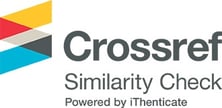Pengaruh Leverage dan Arus Kas Operasi terhadap Financial Distress dengan Moderasi Profitabilitas
DOI:
10.33395/owner.v9i4.2814Keywords:
Financial Distress, Leverage, Operating Cash Flow, Profitability, Textile SectorAbstract
The Indonesian textile industry faces intense competition and pressure from imported products, increasing the risk of financial distress. Financial distress, defined as the inability to meet financial obligations, threatens business continuity and is a major concern for investors and creditors. Prior studies on leverage, operating cash flow, and profitability show inconsistent results, leaving a gap in understanding, particularly regarding the moderating role of profitability. This study examines the effects of leverage and operating cash flow on financial distress and tests the moderating role of profitability in textile companies listed on the Indonesia Stock Exchange (IDX) for the 2019–2023 period. Leverage is measured by the Debt to Equity Ratio (DER), operating cash flow by the Operating Cash Flow Ratio (OCF), and profitability by Return on Assets (ROA). Financial distress is identified using the Springate model, with scores below 0.862 indicating distress. Logistic regression with panel data was applied to 10 purposively selected companies, yielding 50 firm-year observations. The findings reveal that leverage significantly affects financial distress, while operating cash flow and profitability show no significant influence. Moreover, profitability does not moderate the effects of leverage or operating cash flow on distress. Theoretically, this study contributes to the Pecking Order Theory by highlighting the limited role of profitability as an internal financing source. Practically, it provides insights for managers, investors, and creditors to strengthen financial sustainability through better capital structure management and profitability improvement.
Downloads
Plum-X Analityc
References
Adair, P., & Adaskou, M. (2015). Trade-off theory vs. Pecking order theory and the determinants of corporate leverage: Evidence from a panel data analysis upon french SMEs (2002–2010). Cogent Economics and Finance, 3(1), 1–9. https://doi.org/10.1080/23322039.2015.1006477
Altman, E. I. (1968). Financial ratios, Discriminant Analysis and the Prediction of Corporate Bankruptcy. The Journal of Finance, 23(4), 586–609. https://doi.org/10.1111/j.1540 6261.1968.tb00843.
Amah, N., R, Z. P., & Agus Sudrajat, M. (2023). Peran Moderasi Profitabilitas pada Pengaruh Leverage, TATO, dan Likuiditas Terhadap Financial distress AKUNESA: Jurnal Akuntansi UNESA, 11(2), 156–170. https://doi.org/10.26740/akunesa.v11n2.p
Bachtiar, A., & Handayani, N. (2022). Pengaruh profitabilitas, leverage, capital intensity, dan arus kas operasi terhadap financial distress. JIRA: Jurnal Ilmu dan Riset Akuntansi, 11(1), 1-19.
Beaver, W. H. (1966). Financial Ratios as Predictors of Failures. Journal of Accounting Research, 4(4), 71–111. https://doi.org/10.2307/2490171
Betari, F. H., & Hanif, A. (2023). Profitability Moderates Institutional Ownership’s Impact on Financial distress. Indonesian Journal of Law and Economics Review, 18(2), 96–107. https://doi.org/10.21070/ijler.v19i0.905
Chandra Das, D. (2022). Assessing Financial Distress and its Association with Leverage, Liquidity and Profitability: Evidence from Textile Industry of Bangladesh. International Journal of Research and Review, 9(11), 451–462. https://doi.org/10.52403/ijrr.20221161
Damiana. (2023, September 15). RI darurat impor tekstil ilegal, Begini penjelasannya. CNBC Indonesia. https://www.cnbcindonesia.com/news/20230915141430-4-472788/ri-darurat-impor-tekstil-ilegal-begini-penjelasannya.
Dewi, A. S., Arianto, F., Rahim, R., & Winanda, J. (2022). Pengaruh Arus Kas, Profitabilitas Dan Leverage Terhadap Financial Distress Saat Masa Pandemi Pada Perusahaan Manufaktur Terdaftar Di BEI. Owner, 6(3), 2814–2825. https://doi.org/10.33395/owner.v6i3.968
Dirman, A. (2020). financial distress: the impacts of profitability, liquidity, leverage, firm size, and free cash flow. International Journal of Business, Economics and Law, 22(1), 17–25.
Dwiantari, R. A., Gede, L., & Artini, S. (2021). The Effect of Liquidity, Leverage, and Profitability on Financial distress (Case Study of Property and Real Estate Companies on the IDX 2017-2019). In American Journal of Humanities and Social Sciences Research (AJHSSR), 5(1), 367–373.
Dwiyani, T., & Purnomo. (2021). Pengaruh Kepemilikan Institusi, Leverage terhadap financial distress dengan profitabilitas sebagai variabel pemoderasi. Pada Perusahaan pertambangan yang terdaftar di BEI tahun 2016-2020. Media akuntansi, 33(2), 32–48. https://doi.org/10.47202/mak.v33i02.126
Fahmi, I. (2014). Analisis Laporan keuangan (D. Handi, Ed.; Cetakan keempat). Bandung: Alfabeta.
Fatika, I. sari, & Pristiana, U. (2024). Pengaruh Keputusan Investasi, Keputusan Pendanaan, Ukuran. Jurnal Pendidikan Tambusai. 8(1), 5779–5790. https://doi.org/10.31004/jptam.v8i1.13287
Fauzy, A. R. (2022). Analisis Cash Flow PT Erajaya Swasembada Tbk. Sebelum dan Semasa Pandemi COVID-19 (Skripsi tidak diterbitkan). PKN STAN.
Fitri, M. A., & Dillak, V. J. (2020). Arus Kas Operasi, Leverage, Sales Growth Terhadap Financial Distress. Jurnal Riset Akuntansi Kontemporer, 12(2), 60–64. https://doi.org/10.23969/jrak.v12i2.3039
Frank, M. Z., & Goyal, V. K. (2003). Testing the pecking order theory of capital structure. Journal of Financial Economics, 67(2), 217–248. https://doi.org/10.1016/S0304-405X(02)00252-0
Hosea, I. A., Siswantini, T., & Murtatik, S. (2020). leverage, profitabilitas, pertumbuhan penjualan terhadap financial distress pada perusahaan ritel di BEI. PROSIDING BIEMA Business Management, Economic, and Accounting National Seminar, 1(4), 60–74.
Isdina, S. H., & Putri, W. W. R. (2021). Pengaruh Laba dan Arus Kas Terhadap Kondisi Financial distress. JIAKES Jurnal Ilmiah Akuntansi Kesatuan, 9(1). 147–158. https://doi.org/10.37641/jiakes.v9i1.490
Jaya, A. S., Rahmanto, B. T. (2022) Pengaruh Likuiditas, Solvabilitas dan Intensitas Modal terhadap Financial distress dengan Profitabilitas Sebagai Pemoderasi pada Sektor Transportasi. KALBISIANA Jurnal Mahasiswa Institusi Teknologi Dan Bisnis, 8(4). 4499–4513. https://doi.org/10.53008/kalbisiana.v10i4.4363
Kuntari, S. E., & Machmuddah, Z. (2021). Pengaruh Rasio Likuiditas dan Leverage Terhadap Financial Distress Dengan Rasio Profititabilitas Sebagai Pemoderasi. Dinamika Akuntansi Keuangan & Perbankan, 10(2), 145–155 https://doi.org/10.35315/dakp.v10i2.8880
Modigliani, Franco, & Miller, M. H. (1963). Corporate Income Taxes and the Cost of Capital: A Correction. The American Economic Review, 53(3), 433–443. https://www.jstor.org/stable/1809167
Myers, S. C., & Majiuf, N. S. (1981). Corporate Financing And Investment Decisions When Firms Have Information The Investors Do Not Have. Journal of Financial Economics, 13(2), 187–221. https://doi.org/10.1016/0304-405X(84)90023-0
Nuresa, A., & Hadiprajitno, B. (2013). Pengaruh Efektivitas Komite Audit Terhadap Financial Distress. Diponegoro Journal Of Accounting, 2(2), 1–10.
Purwaningsih, E., & Safitri, I. (2022). Pengaruh Profitabilitas, Likuiditas, Leverage, Rasio Arus Kas dan Ukuran Perusahaan Terhadap Financial distress. JAE (jurnal akuntansi dan ekonomi), 7(2), 147–156. https://doi.org/10.29407/jae.v7i2.17707
Rays, M., & Sintia. (2022). The Effect of Liquidity, Leverage and Sales Growth on Financial distress with Profitability as a Moderating Variable (Empirical Study of Textile and Garment Industry Sub-Sector Companies). In Journal Intelektual, 1(2), 165-181.
Rodhiyah, rufatur, Indira, I., Prista Dilasari, A. (2023) Peran Moderasi Profitabilitas Terhadap Faktor Prediksi Financial distress. Jurnal Manajemen Riset inovasi, 1(1) ,118–134. https://doi.org/10.55606/mri.v1i1.638
Saleem, R., Hussain, A., & Ibraheem, R. (2020). Banking Industry Specific Determinants of Financial distress: Empirical Evidence from ASEAN Countries. IRASD Journal of Economics, 2(2), 113–123. https://doi.org/10.52131/joe.2020.0202.0020
Sandika, E. F., Kusumawardhani, R., & Rinofah, R. (2023). pengaruh arus kas pendanaan dan leverage terhadap financial distress dengan profitabilitas sebagai variabel moderasi pada perusahaan properti dan real estate periode 2019-2022 yang terdaftar di bursa efek indonesia. Jurnal Orientasi Bisnis Dan Entrepreneurship (JOBS), 4(2), 177–187. https://doi.org/10.33476/jobs.v4i2.4159
Sherly, E. N., & Fitria, D. (2019). pengaruh penghindaran pajak, kepemilikan institusional, dan profitabilitas terhadap biaya hutang (Studi Empiris Pada Perusahaan Manufaktur Yang Terdaftar Di BEI Periode2011?2015). KOMBIS REVIEW: Jurnal Ilmiah Ekonomi Dan Bisnis, 3(7), 58–69. https://doi.org/10.37676/ekombis.v7i1.701
Sugiharto, B., Eka Putri, T., & Nur’alim, R. M. (2021). the effect of liquidity, leverage, and sales growth on financial distress with profitability as moderating variables (Case study of manufacturing companies listed on the Indonesia. JASS (Journal of Accounting for Sustainable Society), 3(1), 70–93. https://doi.org/10.35310/jass.v3i01.895
Suharti, S. (2023). Pengaruh Rasio Keuangan terhadap Financial distress dengan Firm Size sebagai Variabel Moderasi. Jurnal Ekobistek, 12(2), 646–651. https://doi.org/10.35134/ekobistek.v12i2.599
Syafira, C. (2023). Pengaruh Kinerja Keuangan Dan Arus Kas Operasi Terhadap Financial Distress Dengan Ukuran Perusahaan Sebagai Variabel Moderasi. Jurnal Ilmu dan Riset Akuntansi, 13(2), 1–26.
Utami, M. A., Sumiati, A., & Musyaffi, M. (2023). the effect of leverage and operating cash flow on financial distress with profitability as a moderation variable in mining companies listed on the indonesia stock exchange (idx) 2019-2022 periode. In International Journal of Current Economics & Business Ventures 1(3), 131–146.
Whitaker, R. B. (1999). The Early Stages of Financial distress. Journal of Economics and Finance. Journal of Economics and Finance, 23(3), 123–132. https://doi.org/10.1007/BF02745946
Wijaya, J., & Suhendah, R. (2023). Pengaruh Likuiditas, Leverage, Dan Arus Kas Terhadap Financial Distress. Jurnal Ekonomi, 28(2), 177–196. https://doi.org/10.24912/je.v28i2.1468
Wilujeng, R., & Yulianto, A. (2020). Determinan Financial Distress dengan Profitabilitas Sebagai Variabel Moderating. Jurnal Penelitan Ekonomi Dan Bisnis, 5(1), 90–102. https://doi.org/10.33633/jpeb.v5i1.2746
Zain, A. (2022). Analisis Financial Distress Pada Perusahaan Yang Terdaftar Di Bei (Studi Empiris Pada Perushaan Sektor Bahan Baku, Perindustrian, Barang Konsumen Primer Dan Infrastuktur Tahun 2016-2020) (Skripsi tidak diterbitkan). STEI Jakarta Indonesia.
Downloads
Published
How to Cite
Issue
Section
License
Copyright (c) 2025 Fatimah Azzahra, Eli Safrida, Anggiat Situngkir, Ilham Hidayah Napitupulu, Putri Syuhada

This work is licensed under a Creative Commons Attribution-NonCommercial 4.0 International License.
















